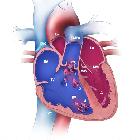Meckel-Syndrom






Meckel-Gruber syndrome (MGS) is classically characterized by the triad of:
Additional hepatic developmental defects and hepatic fibrosis may occur. A variety of malformations may be associated with this syndrome but most agree that cystic renal dysplasia must be present with at least one of the other two anomalies in the classic "triad".
Epidemiology
The incidence is estimated to be 1:30,000. A disproportionately higher prevalence may be present in Finland, Belgium and in some parts of India.
Associations
Central nervous system/craniofacial
- microcephaly
- fetal ventriculomegaly
- agenesis of corpus callosum
- Dandy-Walker malformation
- micrognathia
- cleft lip +/- palate
Cardiac and vascular malformations
- cardiac rotational abnormalities
- ventriculoseptal defect (VSD)
- aortic hypoplasia
- aortic coarctation
- aortic valve stenosis
Musculoskeletal
- webbed neck
- club foot
- syndactyly
- clinodactyly
Gastroenterology
Pathology
Meckel-Gruber syndrome shares some features with trisomy 13 and is therefore also termed pseudotrisomy 13 . Karyotyping is recommended if the above triad is seen on antenatal scanning.
Genetics and inheritance
It is inherited as an autosomal recessive fashion, the risk of the condition affecting a subsequent child is therefore 25% . There is genetic heterogeneity with at least three genes (MKS1, MKS2 and MKS3) having been identified :
- MKS1: on chromosome 17q
- MKS2: on chromosome 11q
- MKS3: on chromosome 8q or 13 q
Markers
Radiographic features
Antenatal ultrasound
In addition to the demonstration of the classical features such as an occipital encephalocele, multiple renal cysts and polydactyly, there may be evidence of oligohydramnios (or anhydramnios in severe cases) and microcephaly).
In utero (and early neonatal life) multicystic renal disease is usually evident as enlarged echogenic kidneys: demonstration of physical cysts within the kidneys only occurs in the minority of cases.
Treatment and prognosis
The condition is almost always fatal at birth either because of pulmonary hypoplasia or neonatal renal failure . Parents can be counseled appropriately that the subsequent risk is 25%.
History and etymology
Meckel-Gruber syndrome is named after:
- Johann Friedrich Meckel (the younger) (1781-1833) German anatomist (also known for Meckel diverticulum)
- Georg Gruber (1884-1977) German physician : who first described the constellation of findings in 1934, terming it dysencephalia splanchnocystica
Although it was only in 1969 that the moniker "Meckel-Gruber syndrome" was coined by Opitz and Howe .
Siehe auch:
- Aortenisthmusstenose
- Pätau-Syndrom
- Meckel-Divertikel
- Polydaktylie
- Klinodaktylie
- Lungenhypoplasie
- Oligohydramnion
- Klumpfuß
- Holoprosencephalie
- Mikrognathie
- fetal ventriculomegaly
- Syndaktylie
- Dandy-Walker-Syndrom
- Mikrozephalie
- Lippen-Kiefer-Gaumen-Spalte
- Meningoenzephalozele
- Anhydramnion
- Dysgenesie des Corpus callosum
- Ventrikelseptumdefekt
- cystic renal dysplasia
- elevated maternal alpha feto protein (MSAFP)
und weiter:

 Assoziationen und Differentialdiagnosen zu Meckel-Syndrom:
Assoziationen und Differentialdiagnosen zu Meckel-Syndrom:

















